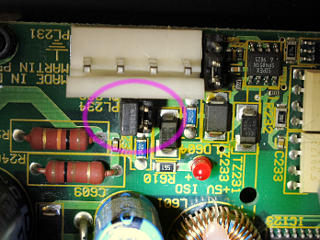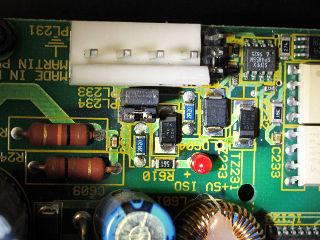
|
After a decade or more of ownership, not to mention wiring adaptation at
every gig they went to, I finally dug in and "un-flipped" the DMX data
line polarity on my Martin 918s. They had originally come in "Martin
RS485" mode, where pin 2 of the XLR connector is data (+) and pin 3
is (-), but the standard DMX spec is the reverse of that [on both 3 and
5 pin connectors]. With only the four of these lights generally used in
local pairs, a small fistful of data-line adaptors got me through all the
shows to date, but now that someone else was about to work the units
into his own design it was time to make them more compatible with modern
setups.
|

|

|
|
| Flipped | Straight | |
|
The jumpers are right behind the connector as indicated. Fixing the
polarity requires removing both jumpers and restoring them to the new
position shown. An easy enough fix, just a bit cumbersome to get to.
It looks a lot easier as presented in the
manual
(pdf, 932k),
but having a few real-world pictures and discussion can't hurt.
If you think about what this needs to do electrically, it becomes obvious that the square layout of jumper-block pins has to have its circuitry routed something like this:
XLR pin 3 in -------o o------ data (+) to board
data (-) to board -------o o------ pin 2 in from XLR
and placing the jumpers straight across or 90ed acts like a typical
double-pole reversing switch, similar to four-way types used in
household electrical systems where more than two different wall
switches can all control one light. That's all there is to it.
It's also ironically telling that many more modern units can automatically sense which polarity they're receiving and simply adapt on the fly without human intervention. Why Martin ever gained enough market influence to get away with making gear in violation of the spec is beyond me, but then again the "spec" was still rather new back when they were ramping up their product lines and maybe they just didn't know which way would ultimately be considered the right way. At least they made it user-configurable in some of the later units; the Roboscan 518, for example, is hardwired on the "wrong" Martin pin-2-hot setup and since I had been using some of those in rigs I worked with, that had been one prime motivator for leaving the 918s set "wrong" as well all those years. | ||